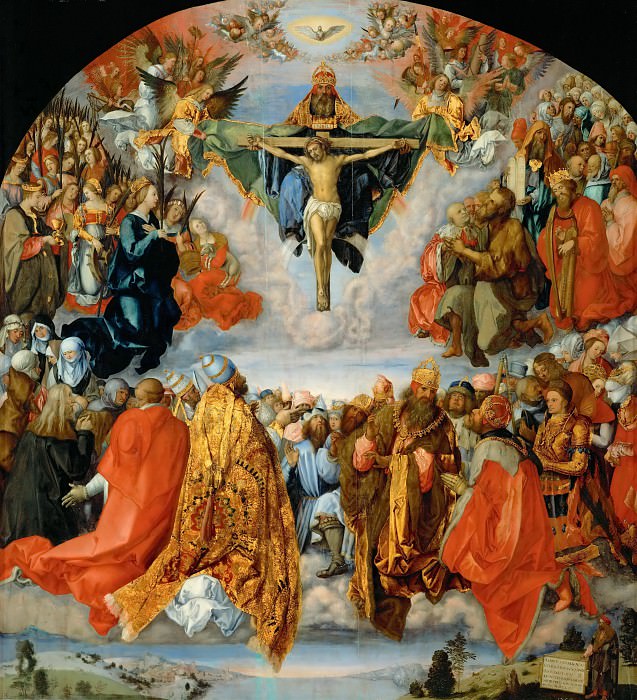The Adoration of the Holy Trinity (Landauer Altarpiece) Albrecht Dürer (1471-1528)
Albrecht Dürer – The Adoration of the Holy Trinity (Landauer Altarpiece)
Edit attribution
Image taken from other album: gallerix.org/s/1560281550/N/764545541/
Download full size: 4234×4658 px (7,4 Mb)
Painter: Albrecht Dürer
Location: Museum of Art History, Vienna (Kunsthistorisches Museum).
One of Dürer’s most solemn works is The Adoration of the Holy Trinity. In 1511 the artist was commissioned by the merchant and owner of a brass workshop, Matthias Landauer. The work was intended for the altar of the chapel in the almshouse for 12 lonely artisans, which the merchant had built. Landauer wished that his wards would pray for the salvation of his soul. The artist painted a picture very solemn, as it is supposed to be the altar.
Description of Albrecht Dürer’s The Adoration of the Holy Trinity (1511).
One of Dürer’s most solemn works is The Adoration of the Holy Trinity. In 1511 the artist was commissioned by the merchant and owner of a brass workshop, Matthias Landauer. The work was intended for the altar of the chapel in the almshouse for 12 lonely artisans, which the merchant had built. Landauer wished that his wards would pray for the salvation of his soul.
The artist painted a picture very solemn, as it is supposed to be the altar. The image of the Trinity is painted traditionally. In the center of the picture is the Holy Trinity - the Holy Spirit incarnate in a dove, God the Father, Jesus Christ crucified on the cross. In the upper left corner, the Mother of God and the martyrs are depicted; in the upper right corner, John the Baptist, the sibyls, and the prophets are depicted. In the lower left corner, the picture depicts the Holy Fathers, Church figures. Among them is a portrait of Matthias Landauer in a brown cloak, bowing his head in prayer to the Holy Trinity. In the upper right corner are depicted the laity, led by the king and the emperor. Among them can be seen both knights and peasant, noble and rich people.
The master painted the picture so that the audience, looking at it thought that the terrible trial had passed, and justice, equality and fraternity reigned. Dürer conveyed the basic idea of equality before the Path of Mercy, where there are no rich or poor, nobles or commoners.
The entire bottom edge of the painting is occupied by a landscape with the figure of a man on the right. The lonely man in the picture is Dürer. He has depicted himself sadly, standing on the ground by the lake, where there is a cartouche with the signature of the author.
The ratio of the figures towering in the sky to Albert Dürer’s image makes this a monumental work, despite the fact that the painting itself is not large.
Кому понравилось
Пожалуйста, подождите
На эту операцию может потребоваться несколько секунд.
Информация появится в новом окне,
если открытие новых окон не запрещено в настройках вашего браузера.
You need to login
Для работы с коллекциями – пожалуйста, войдите в аккаунт (open in new window).
















COMMENTS: 1 Ответы
Один из прекрасных живописных шедевров Дюрера! Удивительное и сверкающее восхитительными красками творение великого немца было создано в 1511г по заказу купца М. Ландауэра. Композиция картины симметрична, уравновешенна и полна гармонии.
Однако, есть только одна деталь, которая нарушает эту гармоничность-в правом нижнем углу шедевра-одинокая фигура художника на берегу озера...
You cannot comment Why?
The painting depicts a celestial scene centered around the Holy Trinity: God the Father holding the crucified Christ, with the Holy Spirit as a dove descending between them. This iconic representation of the Trinity is surrounded by a multitude of figures.
On the left, we see a crowd of people, many kneeling or bowing in reverence. They appear to represent humanity, possibly the faithful from various walks of life, receiving divine grace. Some figures are dressed in religious attire, suggesting clergy or saints.
On the right, there is another gathering of figures, also in adoration. This side seems to represent the heavenly host, possibly angels, cherubim, and seraphim, as well as saints and martyrs of the Church. The vibrant colors and elaborate garments hint at their celestial status and rejoicing.
The overall composition is circular, creating a sense of unity and the boundless nature of Gods love and salvation. The use of light is particularly striking, emanating from the Trinity and illuminating the surrounding figures, symbolizing divine revelation and spiritual enlightenment.
Subtexts: